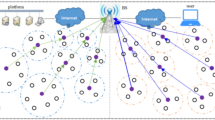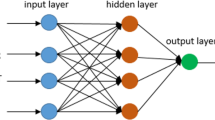Abstract
WSN consists of independent device spatially distributed in the wireless network with sensor that observes the environment conditions. In this paper we propose a new algorithm for transmission head and its function. The cluster head (CH) activities, the role of transmission head (TH) and the selection of TH in various scenarios are discussed. Moreover the residual energy of the head nodes, signal–noise ratio for CH and TH are analysed with simulation results. Section 3 defines the cluster region and the active nodes of the cluster. It defines the identity of each cluster node. Section 3 deals with the selection of CH and the role of TH. Also, the algorithmic approach of TH is explained in this section. Section 4 explains the process of TH to TH communication. The communication of the various clusters is discussed in this section. The final section presents the analysis of TH and CH work with a comparison based on simulation.








Similar content being viewed by others
References
Yick, J., Mukherjee, B., & Ghosal, D. (2008). Wireless sensor network survey. Computer Networks, 52(12), 2292–2330.
Akyildiz, I. F., Su, W., Sankarasubramaniam, Y., & Cayirci, E. (2002). Wireless sensor networks: A survey. Computer Networks, 38(4), 393–422.
Abbasi, A. A., & Younis, M. (2007). A survey on clustering algorithms for wireless sensor networks. Computer Communications, 30(14–15), 2826–2841.
Grady, J., & McDonald, A. (2003). State of the art: Ad hoc networking. Mzones State of the Art Paper.
Agarwal, R., & Motwani, M. (2009). Survey of clustering algorithms for MANET. IJCSE, 1(2), 98–104.
Yi, X., & Deng, L. (2010). A double heads static cluster algorithm for wireless sensor networks. In 2010 2nd conference on environmental science and information application technology.
Li, J., Cao, B., Wang, L., & Wang W. (2013). Energy optimized approach based on clustering routing protocol for wireless sensor networks.
Li, J., Cao, B., Wang, L., & Wang W. (2011). Double cluster-heads clustering algorithm for wireless sensor networks using PSO.
Mehta, S., Sharma, P., & Kotecha, K. (2011). A survey on various cluster head election algorithms for MANET. In International conference on current trends in technology, Nuicone—2011.
Chungtragarn, A., & Keeratiwintakorn, P. (2007). Finding optimized transmission power for clustering of S-MAC protocol in WSNs. In 2007 Proceedings of Asia-Pacific conference on communications.
Khan, B. M., Bilal, R., & Young, R. (2018). Fuzzy-TOPSIS based cluster head selection in mobile wireless sensor networks. Journal of Electrical Systems and Information Technology, 5(3), 928–943.
Zahedi, A. (2018). An efficient clustering method using weighting coefficients in homogeneous wireless sensor networks. Alexandria Engineering Journal, 57(2), 695–710.
Bozorgi, S. M., Rostami, A. S., Hosseinabadi, A. A. R., & Balas, V. E. (2017). A new clustering protocol for energy harvesting-wireless sensor networks. Computers & Electrical Engineering, 64, 233–247.
Oladimeji, M. O., Turkey, M., & Dudley, S. (2017). HACH: Heuristic algorithm for clustering hierarchy protocol in wireless sensor networks. Applied Soft Computing, 55, 452–461.
Raghunathan, V., Schurgers, C., Sung, P., & Srivastava, M. B. (2002). Energy-aware wireless microsensor networks. IEEE Signal Processing Magazine, 1(2), 40–50.
Reddy, S., & Murthy, C. R. (2012). Dual-stage power management algorithms for energy harvesting sensors. IEEE Transactions on Wireless Communications, 11(4), 1434–1445.
da Cunha, A. B., & da Silva, D. C. (2012). Behavioral model of alkaline batteries for wireless sensor networks. IEEE Latin America Transactions, 10(1), 1295–1304.
Heinzelman, W. B., Chandrakasan, A. P., & Balakrishnan, H. (2002). An application-specific protocol architecture for wireless microsensor networks. IEEE Transactions on Wireless Communications, 1(4), 660–770.
Lee, J., & Cheng, W. L. (2012). Fuzzy-logic-based clustering approach for wireless sensor networks using energy predication. IEEE Sensors Journal, 12(9), 2891–2897.
Smaragdakis, G., Matta, I., & Bestavros, A. (2004). SEP: A stable election protocol for clustered heterogeneous wireless sensor networks. In 2th International workshop on sensor and actor network protocols and applications (pp. 1–11).
Muruganathan, S. D., Ma, D. C. F., Bhasin, R. I., & Fapojuwo, A. O. (2005). A centralized energy-efficient routing protocol for wireless sensor networks. IEEE Radio Communications, 43(3), s8–s13.
Lindsey, S., Raghavendra, C., & Sivalingam, K. M. (2002). Data gathering algorithms in sensor networks using energy metrics. IEEE Transactions on Parallel and Distributed Systems, 13(9), 924–935.
Younis, O., & Fahmy, S. (2004). HEED: A hybrid, energy-efficient, distributed clustering approach for ad hoc sensor networks. IEEE Transactions on Mobile Computing, 3(4), 366–379.
Huang, Z., Okada, H., Kobayashi, K., & Katayama, M. (2012). A study on cluster lifetime in multi-hop wireless sensor networks with cooperative MISO scheme. Journal of Communications and Networks, 14(4), 443–450.
Gao, X., Vanq, Y., & Zhou, D. (2012). Coverage of communication-based sensor nodes deployed location and energy efficient clustering algorithm in WSN. Journal of Systems Engineering and Electronics, 21(4), 698–704.
Choi, W., & Woo, M. (2006). A distributed weighted clustering algorithm for mobile ad hoc networks.
Fu, J., Huan, Q., & Peng, H. (2017). Single-channel mixed signal detection based on signal noise ratio estimation. China National Digital Switching System Engineering and Technological Research Center Zhengzhou
Author information
Authors and Affiliations
Corresponding author
Additional information
Publisher's Note
Springer Nature remains neutral with regard to jurisdictional claims in published maps and institutional affiliations.
Rights and permissions
About this article
Cite this article
Sakthy, S.S., Bose, S. Optimising Residual Energy Transmission Head with SNR Value in Multiple Clusters. Wireless Pers Commun 108, 107–120 (2019). https://doi.org/10.1007/s11277-019-06390-2
Published:
Issue Date:
DOI: https://doi.org/10.1007/s11277-019-06390-2




